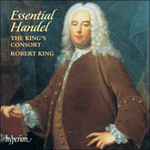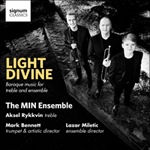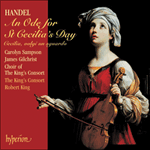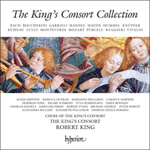
Welcome to Hyperion Records, a British classical label devoted to presenting high-quality recordings of music of all styles and from all periods from the twelfth century to the twenty-first.
Hyperion offers both CDs, and downloads in a number of formats. The site is also available in several languages.
Please use the dropdown buttons to set your preferred options, or use the checkbox to accept the defaults.

The ode opens with a splendid overture with which Handel seems to have been particularly pleased, since he converted it into his Grand Concerto in D major (Op 6 No 5) a month after composing it. The accompanied recitative just mentioned follows and the chorus enters to close Dryden’s first stanza in jubilant style. The stanzas describing the attributes of the various instruments are all set with appropriate instrumental solos (though Dryden’s ‘flute’ was a recorder rather than the transverse flute prescribed by Handel) and are admirably contrasted in mood. ‘What passion cannot Music raise and quell!’, with its gorgeous cello solo representing Jubal’s lyre, and the solemn tribute to the organ show Handel at his most expressive, while the celebration of the war-like qualities of the trumpet is one of his most exciting movements. Handel seems to have added the more formal March (not prescribed by Dryden) to bring back a more sedate mood, again using a motive from Muffat. The sprightly hornpipe with which Orpheus apparently leads the wild beasts is perhaps a shade incongruous, but it is a light-hearted moment which allows the magnificent setting of the final verse to unfold all the more powerfully. The soprano soloist begins to declaim Dryden’s lines in a hymn-like major-key melody, each phrase echoed by the full chorus, but at the mention of the ‘crumbling pageant’ of the ‘last and dreadful hour’ the music turns into minor-key mode and passes through dark modulations to A flat major, the key furthest from the tonic key of D major. The soprano and a solo trumpet then emerge majestically from the gloom to restore the home key and prepare for the final fugue, a grandiloquent extension of a subject taken from Muffat. Handel, a man of plain and devout belief, could contemplate the Last Judgement with unclouded optimism.
from notes by Anthony Hicks © 2004
L’ode s’ouvre par une ouverture splendide dont Haendel semble avoir été particulièrement heureux, puisqu’il la transforma pour en faire son Grand Concerto en ré majeur (opus 6 no5), un mois après l’avoir composée. S’ensuivent le récitatif accompagné cité ci-dessus et le chœur qui conclut la première strophe de Dryden dans un style jubilatoire. Les strophes décrivant les attributs des divers instruments sont toutes réalisées avec des solos instrumentaux appropriés (même si la «flûte» de Dryden désignait plutôt la flûte à bec que la traversière exploitée par Haendel). Elles font preuve de climats admirablement contrastés. «What passion cannot Music raise and quell!», avec son glorieux solo de violoncelle représentant la célébration la lyre de Jubal et l’hommage solennel de l’orgue témoignent d’un Haendel au zénith de son expressivité, tandis que les célébrations des qualités guerrières de la trompette font de ce mouvement l’un des plus passionnants. Haendel semble avoir ajouté une Marche plus formelle (non indiquée par Dryden) pour ramener à une atmosphère plus sereine, en se servant de nouveau d’un motif de Muffat. La hornpipe bondissante par laquelle Orphée conduit apparemment les bêtes sauvages, semblerait presque incongrue. Il s’agit d’un moment débonnaire qui permet en fait à la réalisation superbe de la dernière strophe de se déployer avec plus de force encore. La soprano solo entame sa déclamation des lignes de Dryden par une mélodie en majeur aux allures d’hymne, chaque phrase étant reprise en écho par le chœur au complet. Aux mots «crumbling pageant» de la «last and dreadful hour», la musique se change en mineur et passe à travers une série de sombres modulations vers la bémol majeur, la tonalité la plus éloignée de la tonalité principale, ré majeur. La soprano et une trompette solo émergent majestueusement de ces sombres ténèbres pour retrouver la tonalité principale et préparer la fugue finale, une extension grandiloquente d’un sujet tiré de Muffat. Haendel, un homme d’une foi expansive et dévouée, pouvait contempler le Jugement dernier avec un optimisme radieux.
extrait des notes rédigées par Anthony Hicks © 2004
Français: Isabelle Battioni
Die Ode beginnt mit einer großartigen Ouvertüre, mit der Händel besonders zufrieden gewesen sein muss, da er sie einen Monat nach ihrer Entstehung in sein Grand Concerto in D-Dur (op. 6 Nr. 5) umwandelte. Auf die Ouvertüre folgt sofort das oben genannte Accompagnato-Rezitativ und die erste Strophe Drydens wird vom Chor jubelnd beendet. Die Strophen, in denen die verschiedenen Instrumente beschrieben werden, sind alle mit entsprechenden Instrumentalsoli versehen (obwohl Dryden mit „Flöte“ die Blockflöte meinte und nicht die von Händel verlangte Querflöte) und sind sehr unterschiedlich angelegt. Besonderen Ausdruck verleiht Händel der Strophe „Welch’ Leidenschaft kann die Musik nicht erregen und auch bändigen!“, in der ein herrliches Solo für Violoncello, das die Leier des Jubal darstellt, und eine feierliche Hommage an die Orgel erklingen. In der darauffolgenden Strophe hingegen kommen die kriegerischen Eigenschaften der Trompete auf besonders lebendige Art und Weise zum Ausdruck. Händel scheint den etwas formelleren Marsch (der von Dryden nicht vorgesehen ist) eingefügt zu haben, um danach wieder für eine etwas beherrschtere Stimmung zu sorgen; hierbei verwendet er wiederum ein Motiv Muffats. Die muntere Hornpipe, mit der Orpheus offensichtlich die wilden Tiere bändigt, ist vielleicht ein wenig unpassend, jedoch bietet sie einen unbeschwerten Augenblick, auf den dann die großartige Vertonung der letzten Strophe umso würdevoller folgen kann. Die Solosopranistin deklamiert Drydens Verse zunächst in einer hymnusartigen Durmelodie, wobei jeder Satz vom Chor wiederholt wird. Als jedoch vom „bröckelnden Fest“ und der „letzten furchtbaren Stunde“ die Rede ist, wechselt die Musik nach Moll und es erklingen düstere Modulationen nach As-Dur, der am weitesten entfernten Tonart von der D-Dur-Tonika. Darauf erheben sich der Sopran und die Solotrompete majestätisch aus der Dunkelheit, kehren schließlich zur Haupttonart zurück und leiten die Schlussfuge ein, eine grandiose Erweiterung eines Muffatschen Themas. Händel, ein Mann einfachen und festen Glaubens, konnte dem Jüngsten Gericht mit unverfälschtem Optimismus entgegensehen.
aus dem Begleittext von Anthony Hicks © 2004
Deutsch: Viola Scheffel
 Handel: Essential Handel Handel: Essential Handel'here's a good, cheap way to support a company that has immeasurably enriched the collections of legions of record buyers over a quarter of a century ...» More |
 Light Divine Light DivineA programme of virtuosic set-pieces for treble voice—the wonderful Aksel Rykkvin—and chromatic divertissements captured with boundless enthusiasm by the MIN Ensemble of Norway.» More |
 Handel: An Ode for St Cecilia’s Day Handel: An Ode for St Cecilia’s Day |
 The King's Consort Collection The King's Consort Collection'An uplifting disc, and nicely presented—I can certainly recommend this as an example of both fine music and exquisite performances' (MusicWeb Interna ...» More |

